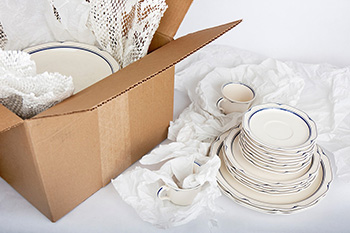 By Julie DeLong, A-1 Freeman Moving Group
By Julie DeLong, A-1 Freeman Moving Group
When packing and moving your household to a new location, some items may not survive the move. This is what's known as a moving casualty, a tragic amount of damage or complete breakage that can happen on move-out day, move-in day, or while the truck bumps along from one home to the next. No matter how carefully you pack, most households experience at least one minor moving casualty during the transition, but you don't have to.
As a professional moving company, we pack a lot of delicate items for our customers to make sure they arrive at the destination unharmed. So, today, we're here to talk about how to prevent the most common moving casualties when you are packing yourself and how to protect your most difficult-to-move items.
Delicate Glassware, Fine China, & Collectibles
There's a reason that professional movers have so many specialized packing materials for moving your dishes. Glassware and ceramic plates are hard enough to move without breaking them, much less fine china and fragile collectibles. Many households see at least one crack or shattered glass item in a move with dozens of fragile items in boxes.
You'll want to take special care packing, stuffing, separating, and padding your most delicate items.
- Use cardboard dishware dividers
- Pack plates upright, this reduces the chance of breaking
- Stuff every hollow space with paper, bubble wrap, or peanuts
- Don't allow glass to touch other glass
- Don't pack too tightly, or pressure/bumps can cause shattering
- Pad extra space and the outside of each box with fluffy packing material
Mirrors & Picture Frames
Large panes of glass are especially tricky to pack because they have a high chance of being cracked or shattered in the move. This means mirrors and glass-covered picture frames need to be packed with special care. The most important thing is to protect the glass surface and minimize the chance of an impact against the glass.
- Stack picture frames together in a box with cardboard dividers in between
- Secure a blanket or cloth over the entire surface of the glass
- Use a large piece of cardboard over each glass surface to minimize impacts
- Store upright, like the plates
- Do not allow packed glass to lay flat
Wood Furniture
Wood furniture is a common moving casualty, but not the entire piece of furniture itself. Instead, wood tends to suffer from scrapes, scuffs, and damage to the finish when being taken apart or hauled through narrow corners and doorways of the house. It's very common for once-pristine wood furniture to arrive at the new house in need of refinishing or repairs. Here's how to prevent damage to your furniture (and walls) along the way:
- Remove hardware like handles and feet to make the furniture more rectangular and even.
- Store all removed hardware together in a clearly labeled bag or box.
- Small sets of removed hardware might be stored in a drawer of the furniture it came from
- Store multiple sets of removed hardware in the same box for easy reconstruction
- Tape All drawers and cabinets shut
- Use paper tape or masking tape which does not damage paint, stain, or finish
- Take large furniture apart if you can.
- Wrap each piece individually and pack into one box or bundle.
- Clearly label anything you take apart, including where the pieces should be reconnected later. Colored tape helps.
- Wrap everything in furniture pads or blankets to minimize the chance of scuffs
- Ask for help or hire professional movers to move large or awkward furniture
Musical Instruments
If you own any musical instruments, know that a move can mean real peril for these finely tuned and delicate items. From grand pianos to clarinets and everything in between, instruments tend to be fragile and need to be treated with the utmost care.
For large instruments like pianos, harps, and acoustic bass, you may need to work with a specialized instrument moving team. Talk to your moving company about what they can do or services they can connect you with who specialize in moving large instruments safely across long or short distances.
For smaller personal instruments, these steps can help you keep your musical equipment safe and in good condition during the move:
- Loosen the strings of all stringed instruments like guitars, violins, cellos, and small harps. The temperature and humidity changes during a move or while in storage can cause strings to snap or even warp the wood of your instrument if the strings are too tight.
- Pack mouthpieces separately and consider carrying your mouthpieces with you rather than packing them in a box.
- Pack instruments inside their own shaped and padded cases if possible.
- If practical, wrap instruments in bubble wrap, even inside their cases, to provide additional insulation and protection.
- If you don't have a case wrap the instrument in several layers of bubble wrap and then pack in its own box with nothing else inside.
- Pad the box with paper, clothing, bubble wrap, or peanuts to prevent wiggling and bumping.
- Never pack two instruments in the same box in case they damage each other on the move.
- If it's a possibility, consider moving instruments in your vehicle instead of on the moving truck.
Artwork
 Whether you have posters, painted canvas, or sculptures, packing art can be tricky. There's a good chance your art will survive the move without specialized moving services, but only if you pack it the right way and are careful about where it's placed in the moving truck. For very high-priced items, talk to your moving company about whether you should consider moving them in your car or shipping with an art transport service.
Whether you have posters, painted canvas, or sculptures, packing art can be tricky. There's a good chance your art will survive the move without specialized moving services, but only if you pack it the right way and are careful about where it's placed in the moving truck. For very high-priced items, talk to your moving company about whether you should consider moving them in your car or shipping with an art transport service.
However, if you've just got a few delicate pieces of artwork to pack and take along, here's how to keep them from becoming moving casualties:
Canvas & Posters
- Decide if it's safe to roll up your artwork and store in poster tubes. Upright, sturdy poster tubes are often the safest way to go.
- If storing flat, consider keeping inside picture frames which are already packed carefully to reduce bumps.
- If storing flat, use a thin flat box about the size of your artwork
- Lay your canvas or poster between sheets of cardboard to keep them both flat and protected
- Consider plastic wrap, wax paper or even a quick spray of paint-sealant for unsealed paintings or sketches
Fragile or Oddly Shaped Sculptures
- Like dishes, fill every crevice, cavity, and handle with fluffy packing material
- Like instruments, place in a bed of packing material and surround with more packing material to protect from bumps or compression
- Metal and wood can be stored in the same box
- In general, do not pack two glass or breakable sculptures in the same box
Workout Equipment
Finally, we come to the sturdiest but perhaps most difficult packing task of all: your workout equipment. Weights, weight benches, exercise bikes, and specialized workout equipment are often a huge challenge to move. The weighted and structural pieces can be very heavy while the equipment itself can be complex and/or bulky to move. In fact, large workout equipment is often the cause of moving casualties.
Sporting equipment, on the other hand, can be quite delicate. Rackets and skis, snowboards and surfboards, and other finely wrought sporting gear can take serious damage from the wrong kind of jostling during a move. These are things you don't want to simply throw in a box and go.
Here's how to move your home gym and sporting gear safely without any breaks, losses, or too-heavy boxes:
Weights
- Pack one or two per box
- Pad tightly and pack into small now-heavy boxes
- Look for or construct boxes smaller than a book box
- Pack disc weights in manageable stacks
- Wrap in furniture pads and secure with shrink wrap
- Never pack a group of weights heavier than you can carry
- Lift with your legs
Workout Equipment
- Keep and pack the assembly instructions
- Disassemble anything you can and pack in bundles of bars and bench pieces
- Label each part and screw as you disassemble and store in labeled bags together with the workout equipment pieces
- Take pictures before you disassemble to help with reassembly
Sporting Equipment (Rackets, Skis, etc.)
- Store rackets in their cases with an extra layer of padding. Do not allow to flex.
- Bubble-wrap skis and boards then pack into cases or upright boxes.
- Consider additional cardboard or struts to keep boxes impact-resistant and rigid
- A professional mover can supply boxes, if you need them
- Pack sets of equipment together in the same box.
----
Moving to a new home doesn't have to include the usual moving casualties like furniture scrapes or broken plates. Whether you're moving large everyday items or special delicate possessions, these tips will help you enjoy a tragedy-free move with every one of your favorite items making it safe-and-sound to your new home. If you're looking for more smart moving tips from a professional moving company who has seen it all or you're worried about moving special items in your home, contact us today!
Request a free quote


 By Julie DeLong, A-1 Freeman Moving Group
By Julie DeLong, A-1 Freeman Moving Group  Whether you have posters, painted canvas, or sculptures, packing art can be tricky. There's a good chance your art will survive the move without specialized moving services, but only if you pack it the right way and are careful about where it's placed in the moving truck. For very high-priced items, talk to your moving company about whether you should consider moving them in your car or shipping with an art transport service.
Whether you have posters, painted canvas, or sculptures, packing art can be tricky. There's a good chance your art will survive the move without specialized moving services, but only if you pack it the right way and are careful about where it's placed in the moving truck. For very high-priced items, talk to your moving company about whether you should consider moving them in your car or shipping with an art transport service. 
